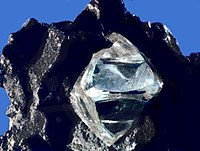
Photo from wikipedia
Abstract Multilayer diamond films were deposited on a reaction bonded silicon carbide (RB-SiC) substrate by a single-step continuous process as well as a three-step intermittent process in a hot filament… Click to show full abstract
Abstract Multilayer diamond films were deposited on a reaction bonded silicon carbide (RB-SiC) substrate by a single-step continuous process as well as a three-step intermittent process in a hot filament chemical vapour deposition (HF-CVD) equipment. The recipes of HF-CVD during the single-step multilayer film (C-MC) were selected by varying the CH4/H2 concentration and chamber pressure such that the initially deposited diamond grains were microcrystalline, which became progressively finer with further deposition. In the case of the intermittently grown films (Ix-MC), a one, two and three-layered structure, each layer having a gradual decrease in grain size was deposited with the same recipes as that of the C-MC. All the films were characterised using SEM, AFM and Raman spectroscopy. Fine grains in the range of 0.2–0.7 μm were identified in the C-MC and sharply faceted diamond crystallites having sizes between 0.5- 2 μm were seen in the intermittently deposited coatings. The hardness values were 71 GPa, 56 GPa and 46 GPa for the intermittent coatings. In contrast, a lower hardness of 29 GPa was obtained in C-MC. The friction coefficients of all the diamond films were measured up to 106 sliding cycles (530 m) using a ball-on-disc universal tribometer. In the initial stages of sliding, the continuously grown C-MC exhibited a friction coefficient ~0.17, while the intermittently coated three-layered film (I3-MC) showed a friction coefficient of 0.28. However, beyond 40,000 sliding cycles, the friction coefficient of I3-MC showed a value of ~0.05, which was slightly lower than C-MC (~0.06).
Journal Title: Diamond and Related Materials
Year Published: 2020
Link to full text (if available)
Share on Social Media: Sign Up to like & get
recommendations!